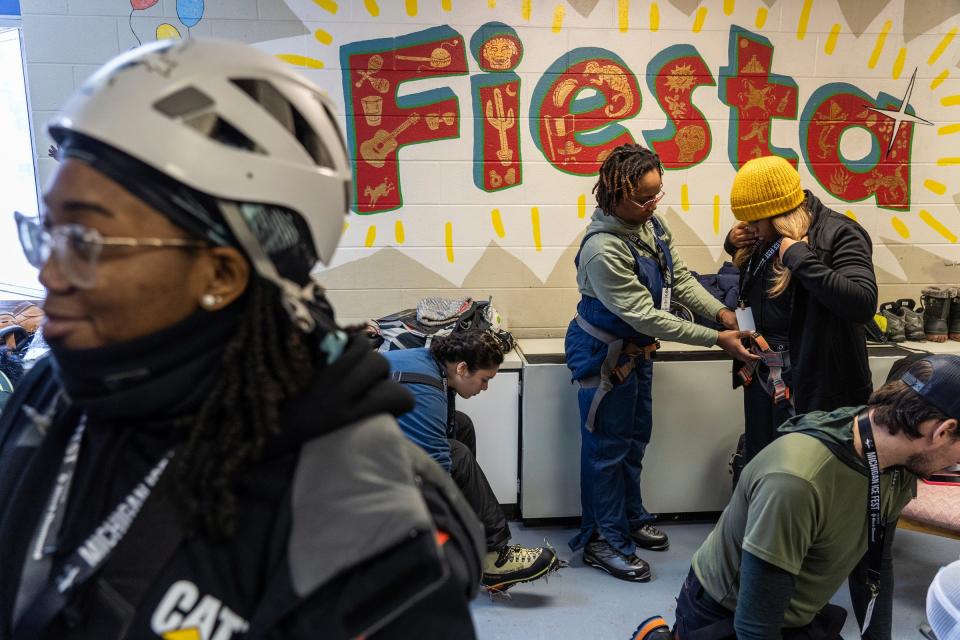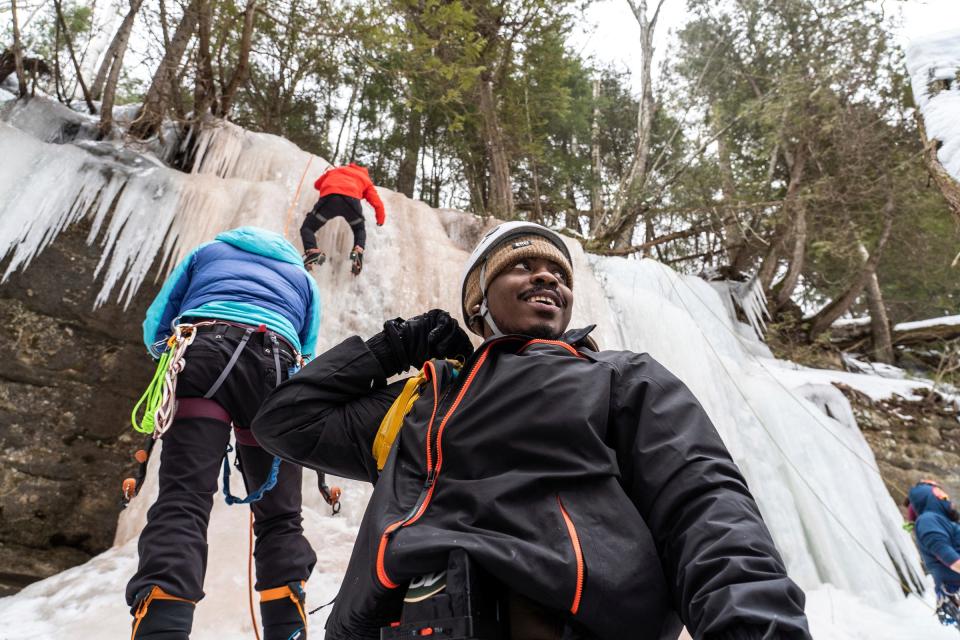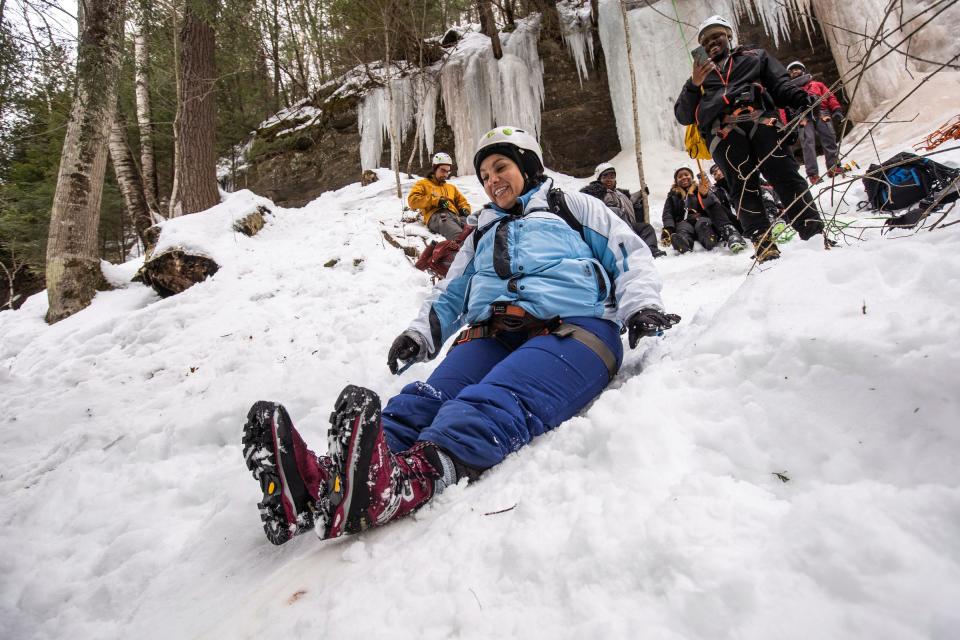Nature advocates make climb to coax people of color to enjoy Michigan's outdoors
Mekha El-Rashidi checked his ice ax's hold, the grip of the crampon claws on his boots, the tension in the ropes. He swung his other ice ax above him and pulled and rolled himself over a lip to the top of a frozen waterfall.
El-Rashidi was far outside his comfort zone, and not just because this was the first real ice climb for someone used to indoor climbing gyms or rocks out West. El-Rashidi, a Black man from Pontiac, was surrounded by a group of fellow Black ice climbers earlier this month at the Munising Ice Fest far into the Upper Peninsula — where the small, rural population is 86% white and 1% Black.
He had heeded calls from Ice Fest organizers who made presentations in Detroit, trying to generate interest for people of color in the event more than six hours away by car. In addition to El-Rashidi, who came on his own, a busload of Black climbers came up from Detroit, joined by climbers of color from Grand Rapids, Memphis and the Twin Cities.
Enjoying the outdoors: Trying new things in new places
"There was some fear — fear of potential racism, of facing the unknown," El-Rashidi said. "I wanted to challenge myself: 'I'm going to go to this place that I don't know and do something I've never done before.' "
That's one not-so-small ice climb for a man; one giant leap for bringing more equity to an outdoor recreation world that historically hasn't had it. For a variety of reasons — some going back centuries and involving the ripple effects of generations of systemic racism — participation by people of color in traditional outdoor recreation such as hiking, camping, boating and climbing has lagged behind other demographic groups, with white people dominating the activities. But incrementally, mentor to mentor, group to group, people of color are changing the paradigm.
Garrett Dempsey, a staff member with the environmental nonprofit Sierra Club, works with Detroit Outdoors, a consortium of groups that came together in 2017 to reopen the city of Detroit's lone campground, Scout Hollow in Rouge Park, to overnight youth camping. Dempsey also helped organize a group of Black ice climbers from Detroit to attend the Ice Fest.
More:Great Lakes set record for least mid-February ice cover
More:Eating locally caught freshwater fish can put PFAS in human blood, study says
"When you look at magazine covers or media about outdoor recreation, it's easy to kind of think of it as a place where white, male athletes of some affluence are spending their time," he said. "We wanted to provide an opportunity for someone who doesn't identify with that to have some community, some like-minded folks, some friends that can make them feel comfortable to go into some spaces and some activities that they are not familiar with."

Brad Garmon is the senior strategic adviser and executive director of the Michigan Outdoor Recreation Industry Office, a division of the Michigan Economic Development Corp. It's his job to understand Michigan's outdoor recreators — "what they do, what they want to do, what keeps them from doing what they want to do."
That increasingly has included taking a look at the recreational wants and needs of people of color, particularly in big cities.
"There certainly are disparities; they need to be addressed," he said.
"The common perception might be that people of color are just not interested in outdoor recreation. We've proven time and time again that is just not the case."
Data shows the great outdoor disparity
The divisions in who gets active outdoors are startling.
The National Park Service conducts five-year surveys of those visiting national parks and federal wilderness areas. For fiscal years 2017 through 2021, visitors to national forests were 95.2% white; 1.3% Black or African American, according to survey responses.
The Michigan Department of Natural Resources contracted for an online and by-mail survey of more than 3,000 Michigan adults from October 2021 to January 2022, to help the agency better understand and assess various outdoor recreation issues. When examining outdoor recreation by race or ethnicity, the survey found 85.2% of Black respondents reporting participating in "all activities, including walking." That still trailed other racial demographics, which were at 95% to 99% percent participation in the catch-all category for all outdoor recreation activities.
The disparities widened as the Michigan survey dug deeper:
For "select outdoor activities" of the traditional sort, such as hiking, biking and camping, only 60.9% of Black survey respondents reported taking part, compared with 87.8% of white respondents.
Asked whether they had participated in any trail or road activities in Michigan in the past 12 months, 72.8% of Black respondents said they had, compared with 88.5% of white respondents.
For water activities in the past 12 months, 66.6% of Black respondents said they participated, versus 82.1% of white respondents.
For snow activities in the past 12 months, only 10.1% of Black respondents said they had participated, compared with 37.1% of white survey participants.
The DNR has created a draft Michigan Statewide Comprehensive Outdoor Recreation Plan for 2023-27, a five-year plan required for some federal funding. The plan cites research that in Michigan, 85% of Black families, and 90% of low-income families, live in nature-deprived areas, compared with 15% of white families and 47% of middle-income families.
"Regular physical activity is associated with a reduced risk of many conditions that affect our physical and mental well-being, including heart disease, stroke, hypertension, Type 2 diabetes, depression and anxiety," the plan states. It further cites that in 2020, 31% of adult Black Michigan residents reported being physically inactive, compared with 21% of white adults.
More:Researchers watch Isle Royale wolf survive fall through Lake Superior ice
More:Unusual winter phenomenon happening now beneath U.P.'s Tahquamenon Falls
Restricted spaces, unfamiliar places
"So much of this goes into what I would call a historical restriction of space for Black Americans," said Ian Solomon, a metro Detroit visual artist and journalist who founded Amplify Outside, a nonprofit organization "trying to demystify the outdoors for black Detroiters."
"From redlining (historical maps used by lenders outlining where different ethnic groups lived that helped perpetuate economic disparities) to the placement of the highway system to other literal, infrastructure barriers that have kept Black people in urban centers.

"I always liked nature, but growing up, the nature I got was just on TV, the National Geographic shows. Or seeing the Brady Bunch take their Grand Canyon trip,"
— Djenaba Ali, co-founder of Black to the Land
"When you look at Apple Maps today, you get to the suburbs and suddenly there's a whole lot more parks and forests and recreation spaces. People in the suburbs had the agency and the governmental representation. Their residents fought to create those spaces and were connected enough to the powerful to make it happen."
The Great Migration, the relocation of some 6 million Black Americans from the South to the Midwest and other Northern locales from about 1916 to 1970, meant generations arrived in cities like Detroit with "no ties to Up North, going to the lakes there. There's not a connection there," said Djenaba Ali, a co-founder of Black to the Land, a nonprofit group in Detroit working to expand outdoor recreation opportunities.
"Historically, when you talk about the South, lynchings, not going to the woods. And here, Sundown Towns" — places where Black people historically were at times overtly threatened by white racists to be out of town by sunset. "It's that taught fear."
More:Warmer winters, fewer hunters have Michigan deer numbers soaring — and it's becoming a problem
More:Proposed Stellantis pollution settlement includes tree-planting, money for local school
Black to the Land Coalition co-founder Tepfirah Rushdan compared urban Black residents' discomfort with rural areas where they might see Confederate flags and few who look like them to some outstate Michigan residents' reactions when they come to Detroit "and are like, 'I'm going to get shot up.' "
"If you don't know the rules of a place, it's kind of hard to navigate," she said.
Add in the economic costs of camping or hiking gear, boats or kayaks, and transportation barriers to getting out of the city and into the woods, and, over the years, younger generations don't give outdoor recreation much of a thought.
"I always liked nature, but growing up, the nature I got was just on TV, the National Geographic shows. Or seeing the Brady Bunch take their Grand Canyon trip," Ali said.
Some Black residents are eager to get started with outdoor recreation but don't know where to go, what to do or are worried about missteps, Rushdan said.
"We thought it was very important for other Black and brown folks to see people of color in leadership of events and being the majority people there," she said. "Sometimes, if you are the only Black person at an event, it feels uncomfortable. If it's something you don't know already, and then you don't see people there that reflect you, you kind of shy away, instead of stepping into it like, 'Oh, let me figure out how to pitch the tent; let me get on the water with the kayak.' "
'Browns, Blacks and Kayaks'
Black to the Land promotes a variety of outdoor programming throughout the year, from walks in local parks and swims at Belle Isle to outdoor camping trips to Wilderness State Park in the tip of the Mitten or to the Upper Peninsula.
Last summer marked the group's third annual Browns, Blacks and Kayaks event at Proud Lake Recreational Area in Oakland County. The number of participants has grown every year to last summer's 300 kayakers, including about 150 first-timers, Rushdan said.
"There are people that have some real fears of the water — and especially muddy water; not a swimming pool, a lake. They are a little bit nervous, but they go out anyway. And they face that fear and realize it's OK. And then later they post about it on Facebook, 'I did that,' really proud of themselves.
"There is definitely a niche of nature lovers amongst us that want those experiences and they need a pathway in there. It is such an honor to be able to do that work and support people in that way."
More: Michigan's poorer, minority neighborhoods become 'sacrifice zones' for increased pollution
Other events include Beats and Bonfires, culturally relevant poetry readings around fire rings at parks around Detroit, and working with local Native Americans on cultivating wild rice and creating maple syrup and sugar from sap tapped from trees in Rouge Park, Ali said.
'They didn't know how to get started with it'
Solomon, the Amplify Outside founder, grew up in metro Detroit, living at times on the city's east side and in Macomb County. But it wasn't until his senior year of high school, when his family moved to West Bloomfield, that he connected with the woods and water now suddenly so close.
He got further into hiking in the wild at Arizona State University, then in the mountains around Los Angeles. After moving back to metro Detroit, he continued his outdoor adventures, posted photos and videos on social media, and was surprised at the response.
"What I realized is there is a lot of interest for people in this, but they didn't know how to get started with it," he said.

It grew into Amplify Outside, which has taken urban people of color on camping trips throughout the state, and conducted outdoor "sound healings" in parks around Detroit.
"You bring a yoga mat and just lay down in the park," he said. "There are sound bowls, gongs, a big group session of meditation. It's been incredible, and well-received."
Solomon said he enjoys taking groups camping in the Upper Peninsula.
"I find that when there's not already a connection to the outdoors, it helps to blow someone's mind," he said. "You can tell somebody all day about the benefits of nature, and they might say, 'I spent the day at the city park, and I had a good time, but I really don't see the hype around it.' But to get them out in these endless forests, these waterfalls, these cliffs, these crystal blue, almost Caribbean waters, allows them to fully understand."
'Opportunity and exposure are what we are after'
Last year's survey with DNR was part of an effort to make recreational opportunities more inclusive, and involve people of color in the decision-making, "rather than dictating, 'Everybody do it the way traditionally white-dominated recreation has always been done,' " Garmon said.
That includes improving recreational opportunities and amenities in city parks, up to collaborating with nonprofit groups to help send Black Detroiters to Munising's Ice Fest.
"There are a lot more barriers to do ice climbing than there is to reading a book in the park. But we need to understand the barriers to doing both," Garmon said.
The DNR's effort to connect more to urban communities has included more than $60 million in investment to create Milliken State Park on the Detroit riverfront, convert Belle Isle into a state park and open an Outdoor Recreation Center nearby.
"Our vision was to create an experiential center where people could come and experience what it's like to do outdoor things that maybe they weren't exposed to in the past — sitting in a kayak or RV, looking at different fish species from around the state, an archery range — not just a bunch of things to read and placards," said DNR Parks and Recreation Chief Ron Olson.
The agency is adding outdoor recreational programming at places like Belle Isle, including a "Learn About Hunting" program last August, and working with allied groups to expose families to outdoor recreational pursuits.
More:Southwest Detroit residents rally against Moroun land transfer ahead of City Council vote
More:Michigan's poorer, minority neighborhoods become 'sacrifice zones' for increased pollution
In addition to attempting to diversify DNR staff, the agency has a summer youth employment program, taking some 400 16- to 19-year-old city kids from Detroit, Pontiac, Flint and Saginaw and putting them to work and camping in places Up North like Wilderness State Park.
"Those are valuable experiences," Olson said. "They will go back and tell their parents or guardians what they've experienced, and hopefully draw them into it as well.
"Opportunity and exposure are what we are after."
Building a local, lasting connection
The restored overnight camping experiences at Rouge Park for youth groups can leave a lasting impression, even if the campers never take it any further, Dempsey said.
"They have changed their relationship with the park, with their city," he said. "They now better understand the beauty and resource that's in their hometown. And some folks will be saying, 'I had that experience at home and now I want to build on that and do more.' "
At a recent college readiness and career pathways event for more than 200 Detroit public schools juniors and seniors at Wayne County Community College District, Dempsey manned a station to talk about summer camp employment opportunities.
"One student asked, 'Is the pay good?' I said not at first, but told him about the experiences," Dempsey said. "He took a photo of the flyer.
"But then, as he was walking away, I overheard another student tell him, 'Real talk; this nature stuff is pretty cool,' and how he'd gone camping at Indiana Dunes with YMCA Detroit's Bold & Gold program. How he'd been backpacking at Pictured Rocks and how amazing it was. He started rattling off all of the names of the staff. And how he was thinking about going back to camp at Isle Royale this summer.
"Unsolicited, word of mouth, peer to peer. That's when you know it's working, and things are starting to change."
Get outside, get involved
A number of local nonprofit organizations are working to expand outdoor recreational opportunities for people of color. Several offer free events, or events for a nominal fee. But many also said they don't want an inability to pay to be an obstacle for anyone, and to reach out to discuss options.
For more information on the different groups and their upcoming activities, go to:
Black to the Land Coalition — blacktothelandcoalition.com or their Facebook page, facebook.com/BlackToTheLandCoaltion/
Detroit Outdoors collaborative — https://linktr.ee/detroitoutdoors
Amplify Outside — https://instagram.com/AmplifyOutside
Contact Keith Matheny: kmatheny@freepress.com.
This article originally appeared on Detroit Free Press: Nature advocates make climb to coax people of color to enjoy outdoors

